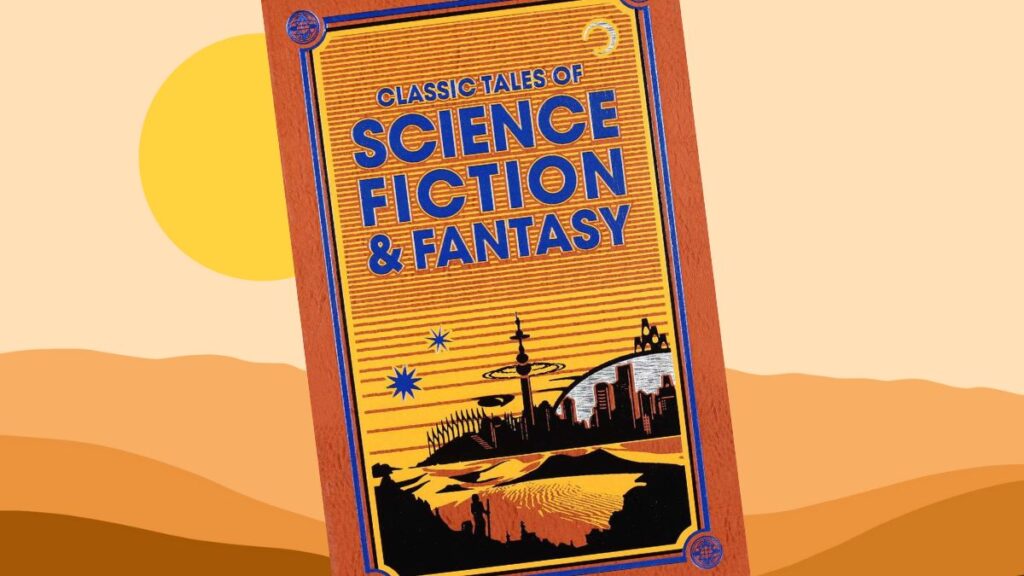By Brian Boone
Dune wasn’t the first science fiction novel, but it certainly helped popularize the genre, establish its tropes, and influence future classic tales of science fiction — just like author Frank Herbert took a page out of the book of his predecessors.
The Earliest Sci-Fi Novels
Written in the 2nd century A.D. in Greece, Syrian author Lucian of Samosata used A True Story to poke fun at the far-fetched mythological tales of his day presented as fact. His first-person account of an adventure into space isn’t true at all but it is the first book to do a lot of things, like show space travel and feature extraterrestrials. In the novella, Lucian and some fellow travelers see their ship get blown off course and they reach the moon and wind up in the middle of a war between moon people and sun people over the right to colonize Venus. (That second part sounds a lot like the plots of H.G. Wells’ War of the Worlds, Dune, and Star Wars.)
Enter H.G. Wells
What’s recognizable as modern science fiction began with the late 19th century works of H.G. Wells. Serialized in the U.S. in 1897 — as fiction, particularly science fiction, was commonly published at that time — The War of The Worlds is the first popular title in the English language to depict an alien invasion and then a fight between humans and those alien invaders. Wells helped launch a boom era in space-based sci-fi, which would also include Edgar Rice Burroughs’ Mars-set 1910s novels featuring John Carter, the 1926 launch of pure sci-fi magazine Amazing Stories, and Philip Francis Nowlan’s adventure stories about daring space rogue Buck Rogers, first published in Amazing Stories in 1928.

How Dune changed everything
Frank Herbert’s Dune was inspired in part by The Sabres of Paradise, a 1960 biography of Imam Shamil, a 19th century Islam uniter and freedom fighter, and his experiences observing the gigantic, alien-looking sand dunes on the Oregon Coast. As was the style of the time, Dune was first published in serial form in periodicals. The novel’s constituent parts, the shorter works “Dune World” and “The Prophet of Dune” appeared in Analog Science Fiction and Fact in 1963 and 1965, respectively. Publishers didn’t think there was a robust enough market for long, serious science fiction, so that’s where Herbert chose to run it first. When he wanted to publish it as a standalone, 400-plus-page book, 20 companies said no; Chilton, an auto manual publisher, said yes.
A bestseller (both in the ‘60s and pretty much forever after), Dune showed that people wanted to buy literary-minded, lengthy sci-fi books. It helped inspire one of the most prestigious honors for science fiction, the Nebula Award — Dune won that body’s first ever prize for Best Novel.
How Dune begat Star Wars
Even though Dune is dense both physically and in terms of content, it turned science fiction into a viable commercial genre. While a film adaptation of Dune wouldn’t arrive until 1984, Herbert’s fingerprints are all over major sci-fi works that came after Dune. Arthur C. Clarke’s 2001: A Space Odyssey (book and film) was ominous, spooky, and thoughtful like Dune and also brought in big questions, theology, and religion. The sandy worlds of the Stargate franchise carried on Dune’s mysterious desert setting.
And then there’s the biggest thing ever in sci-fi: Star Wars. One could argue it smoothed out Dune and made it more kid-friendly and as commercial as possible. Among the similarities between Dune and Star Wars, indicating inspiration: both take place in universes where every planet is made up of one ecosystem, a male savior with significant lineage revealed later is blessed with magical religious powers that he uses to lead the way in a fight between a rebel alliance and the anonymous armies of an evil galactic overlord. Luke Skywalker is Paul Atreides; The Force is Spice.








